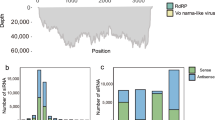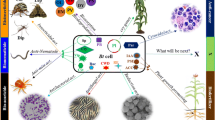Abstract
The gene for a thermal hysteresis (antifreeze) protein (sthp-64) from the bittersweet nightshade, Solanum dulcamara, was cloned and characterized. An expression cDNA library prepared from November S. dulcamara was screened using a polyclonal antibody generated against a previously purified 67 kDa thermal hysteresis protein, and positive clones were identified and sequenced. The full-length thermal hysteresis protein gene was cloned into an Escherichia coli expression vector and expressed as a fusion protein. The putative thermal hysteresis protein (STHP-64) contains two conserved regions 56 and 57 amino acids in length which have the C-X4-C-X22−23-H-X1-H zinc finger motif which is present in WRKY proteins, a family of transcription factors which play a role in regulating expression of pathogenesis-related proteins in plants. Additional features of transcription factors, such as an acidic domain between the two zinc-fingers and a glutamine-rich region upstream of the first zinc-finger are also present in STHP-64. A DNA binding assay showed that the expressed STHP-64 fusion protein has specific DNA-binding ability. A unique feature of STHP-64 is that the C-terminus contains 10 consecutive 13-mer repeats. Such repeats are a common feature of animal antifreeze proteins. The expressed STHP-64 fusion protein had low levels of thermal hysteresis activity, but this activity was considerably increased by addition of citrate, which is known as an enhancer of certain insect antifreeze proteins. Northern blots demonstrated that the STHP-64 transcript was not present in leaves until November and December, suggesting that cold acclimation induces STHP-64 production.
Similar content being viewed by others
References
Andorfer, C.A. and Duman, J.G. 2000. Isolation and characterization of cDNA clones encoding antifreeze proteins of the Pyrochroid beetle Dendroides canadensis. J. Insect Physiol. 46: 365–372.
Bradford, M.M. 1976. A rapid and sensitive method for the quantitation of microgram quantities of protein utilizing the principle of protein-dye binding. Anal. Biochem. 7: 248–254.
Davies, P.L. and Hew, C.L. 1990. Biochemistry of fish antifreeze proteins. FASEB J. 4: 2460–2468.
DeVries, A.L. 1971. Glycoproteins as biological antifreeze agents in antarctic fishes. Science 172: 1152–1155.
DeVries, A.L. 1986. Antifreeze glycopeptides and peptides: interactions with ice and water. Meth. Enzymol. 127: 293–303.
DeVries, A.L. and Cheng, C.H.C. 1992. The role of antifreeze glycopeptides and peptides in the survival of cold-water fishes. In: G.N. Somero, C.B. Osmond and C.L. Bolis (Eds.) Water and Life, Springer-Verlag, Berlin, pp. 301–315.
Doucet, C.J., Byass, L., Elias, L., Worral, D., Smallwood, M. and Bowles, J. 2000. Distribution and characterization of recrystallization inhibitor activity in plant and lichen species from the UK and maritime antarctic. Cryobiology 40: 218–227.
Duman, J.G. 1994. Purification and characterization of thermal hysteresis proteins from a plant, the bittersweet nightshade, Solanum dulcamara. Biochim. Biophys. Acta 1206: 129–135.
Duman, J.G. 2001. Antifreeze and ice nucleator proteins in terrestrial arthropods. Annu. Rev. Physiol. 63: 327–357.
Duman, J.G. and Olsen, T.M. 1993. Thermal hysteresis protein activity in bacteria, fungi, and phylogenetically diverse plants. Cryobiology 30: 322–328.
Duman, J.G., Xu, L., Neven, L.G., Tursman, D. and Wu, D.W. 1991. Hemolymph proteins involved in insect subzero temperature tolerance: ice nucleators and antifreeze proteins. In: R.E. Lee Jr. and D.L. Denlinger (Eds.) Insects at Low Temperatures, Chapman and Hall, London, pp. 94–127.
Duman, J.G., Wu, D.W., Olsen, T.M., Urrutia, M. and Tursman, D. 1993. Thermal-hysteresis proteins. Adv. Low-Temp. Biol. 2: 131–182.
Duman, J.G., Li, N., Verleye, D. and Goetz, F.W. 1998. Molecular characterization and sequencing of antifreeze proteins from larvae of the beetle Dendroides canadensis J. Comp. Physiol. B 168: 225–232.
Griffith, M., Ala, P., Yang, D.S.C., Hon, W.C. and Moffatt, B.A. 1992. Antifreeze protein produced endogenously in winter rye leaves. Plant Physiol. 100: 593–596.
Griffith, M. and Antikainen, M. 1996. Extracellular ice formation in freezing-tolerant plants. Adv. Low-Temp. Biol. 3: 107–139.
Hicks, G.R. and Raikhel, N.V. 1995. Nuclear localization signal binding proteins in higher plant nuclei. Proc. Natl. Acad. Sci. USA 92: 734–738.
Hon, W.C., Griffith, M., Chong, P. and Yang, D.S.C. 1994. Extraction and isolation of antifreeze proteins from winter rye (Secale cereale L.) leaves. Plant Physiol. 104: 971–980.
Hon, W.C., Griffith, M., Mlynarz, A., Kwok, Y.C. and Yang, D.S.C. 1995. Antifreeze proteins in winter rye are similar to pathogenesis-related proteins. Plant Physiol. 109: 879–889.
Ishiguro, S. and Nakamura, K. 1994. Characterization of a novel DNA-binding protein, SPF1, that recognizes SP8 sequences in the 5' upstream regions of genes coding for sporamin and ?-amylase from sweet potato. Mol. Gen. Genet. 244: 563–571.
Jiang, C., Iu, B. and Singh, J. 1996. Requirement of a CCGAC cisacting element for cold induction of the BN115 gene from winter Brassica napus. Plant Mol. Biol. 30: 679–684.
Knight, C.A., Cheng, C.C. and DeVries, A.L. 1991. Adsorption of ?-helical antifreeze peptides on specific ice crystal surface planes. Biophys. J. 59: 409–418.
Kristiansen, E., Pedersen, S., and Ramlov, H. 1999. Antifreeze activity in the cerambycid beetle Rhagium inquisitor. J. Comp. Physiol. B 169: 55–60.
Laemmli, U.K. 1970. Cleavage of structural proteins during the assembly of the head of bacteriophage T4. Nature 227: 680–685.
Li, N., Andorfer, C.A. and Duman, J.G. 1998. Enhancement of insect antifreeze protein activity by solutes of low molecular mass. J. Exp. Biol. 201: 2243–2251.
Liou, Y.C., Thibault, P., Walker, V.K., Davies, P.L. and Fraham, L.A. 1999. A complex family of highly heterogeneous and internally repetitive hyperactive antifreeze proteins from the beetle Tenebrio molitor. Biochemistry 38: 11415–11424.
Liou, Y.-C., Tocilj, A., Davies, P.L. and Jia, Z. 2000. Mimicry of ice structure by surface hydroxyls and water of a ?-helix antifreeze structure. Nature 406: 322–324.
Meyer, K., Keil, M. and Naldrett, M.J. 1999. A leucine rich repeat protein of carrot that exhibits antifreeze activity. FEBS Lett. 447: 171–178.
Newton, S.S. 1999. Purification and identification of thermal hysteresis and other cryoprotective proteins in the bittersweet nightshade (Solanum dulcamara). Ph.D. thesis, University of Notre Dame, Notre Dame, IN.
Olsen, T.M. and Duman, J.G. 1997a. Maintenance of the supercooled state in overwintering Pyrochroid beetle larve Dendroides canadensis: role of hemolymph ice nucleators and antifreeze proteins. J. Comp. Physiol. B 167: 105–113.
Olsen, T.M. and Duman, J.G. 1997b. Maintenance of the supercooled state in overwintering Pyrochroid beetle larve Dendroides canadensis: role of gut ice nucleators and antifreeze proteins. J. Comp. Physiol. B 167: 114–122.
Pater, S.D., Greco, V., Pham, K., Memelink, L. and Kijne, J. 1996. Characterization of a zinc-dependent transcriptional activator from Arabidopsis. Nucl. Acid. Res. 24: 4624–4631.
Ptashne, M. 1988. How eukaryotic transcriptional activators work. Nature 355: 683–689.
Raymond, J.A. and DeVries, A.L. 1977. Adsorption inhibition as a mechanism of freezing resistance in polar fishes. Proc. Natl. Acad. Sci. USA 86: 881–885.
Raymond, J.A., Wilson, P.W. and DeVries, A.L. 1989. Inhibition of growth on nonbasal planes in ice by fish antifreeze. Proc. Natl. Acad. Sci. USA 86: 881–885.
Rushton, P.J., Macdonald, H., Huttly, A.K., Lazarus, C.M. and Hooley, R. 1995. Members of a new family of DNA-binding proteins bind to a conserved cis-element in the promoters of ?-Amy2 genes. Plant Mol. Biol. 29: 691–702.
Rushton, P.J., Torres, J.T., Parniske, M., Wernert, P., Hahlbrock, K. and Somssich, I.E. 1996. Interaction of elicitor-induced DNAbinding proteins with elicitor response elements in the promoters of parsley PR1 genes. EMBO J. 15: 5690–5700.
Sanger, F., Nicklen, S. and Coulson, A.R. 1977. DNA sequencing with chain-terminating inhibitors. Proc. Natl. Acad. Sci. USA 74: 5463–5467.
Sicheri, F. and Yang, D.S. 1995. Ice-binding structure and mechanism of an antifreeze protein from winter flounder. Nature 375: 427–431.
Stintzi, A., Heitz, T., Prasad, V. Wiedemann-Merdinoglu, S., Kauffmann, S., Geoffroy, P., Legrand M. and Fritig, B. 1993. Plant 'pathogenesis-related' proteins and their role in defense against pathogens. Biochimie 75: 687–706.
Taylor, J.D., Ackroyd, A.J. and Halford, S.E. 1994. The gel shift assay for the analysis of DNA-protein interactions. In: G.G. Kneale (Ed.) DNA-Protein Interactions: Principles and Protocols (Methods in Molecular Biology 30), Humana Press, Totowa, NJ, pp. 263–279.
Urrutia, M.E., Duman, J.G. and Knight, C.A. 1992. Plant thermal hysteresis proteins. Biochim. Biophys. Acta 1121: 199–206.
Wang, Z.P., Yang, P.Z., Fan, B.F. and Chen, Z.X. 1998. An oligo selection procedure for identification of sequence-specific DNAbinding activities associated with the plant defense response. Plant J. 16: 515–522.
Worrall, D., Elias, L., Ashford, D., Smallwood, M., Sidebottom, C., Lillford, P., Telford, J., Holt, C. and Bowles, D. 1998. A carrot leucine-rich-repeat protein that inhibits ice recrystallization. Science 282: 115–117.
Yeh, S., Moffat, B.A., Griffith, M., Xiang, F., Yang, D.S.C., Wiseman, S.B., Sarhan, F., Danyluk, J., Xue, Y.Q., Hew, C.L., Doherty-Kirby, A. and Lajoie, G. 2000. Chitinase genes response to cold encode antifreeze proteins in winter cereals. Plant Physiol. 124: 1251–1263.
Author information
Authors and Affiliations
Rights and permissions
About this article
Cite this article
Huang, T., Duman, J.G. Cloning and characterization of a thermal hysteresis (antifreeze) protein with DNA-binding activity from winter bittersweet nightshade, Solanum dulcamara . Plant Mol Biol 48, 339–350 (2002). https://doi.org/10.1023/A:1014062714786
Issue Date:
DOI: https://doi.org/10.1023/A:1014062714786




